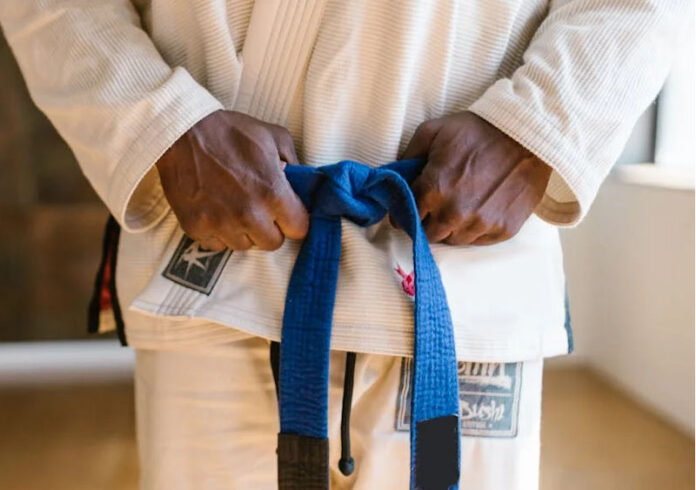The Jiu Jitsu belt ranks mark a practitioner’s growth, skill, and dedication to the art. Unlike many martial arts, Jiu Jitsu belts are earned. You must practice, demonstrate techniques, and understand the sport. Brazilian Jiu Jitsu (BJJ) has a long, respected belt system. It can take years to progress. The journey of the Jiu Jitsu belt ranks requires perseverance. Each stage shows a deeper connection to the art. It is a path of learning and personal growth.
White Belt
The white belt is the starting point for every Jiu Jitsu practitioner. It marks the start of a journey to learn the art and develop basic skills. At this stage, practitioners learn the basics of grappling, positional awareness, and key defenses. The white belt phase is all about building a foundation. Students are taught concepts like escapes, guards, and proper posture in various positions.
Skills Focus:
- Learning basic techniques such as guard passing and positional control.
- Understanding positional hierarchy (mount, side control, guard, etc.).
- Developing core defenses against submissions.
Time to Progress:
- The white belt stage lasts 1-2 years. It depends on dedication and training frequency.
Blue Belt
The blue belt is a key milestone in Jiu Jitsu. It marks the practitioner’s move from beginner to intermediate skill. A blue belt means a deeper understanding of techniques. The practitioner can now use basic moves in live situations. This rank also signifies increased confidence in grappling, positional control, and defensive strategies.

Skills Focus:
- Refining escapes and counters from various positions.
- Learning more advanced techniques, including submissions and sweeps.
- Developing a strategy for controlling opponents and transitioning between positions.
- Beginning to explore individual strengths and style.
Time to Progress:
- Depending on commitment and progress, it generally takes 1-2 years to earn a blue belt after starting as a white belt.
Purple Belt
The purple belt is often seen as the stage where a practitioner truly begins to master Jiu Jitsu. At this rank, students know the basics. They can adapt and use advanced moves in dynamic situations. Purple belts must develop a unique style or game plan. They should tailor their techniques to their physical traits and preferences. This belt also symbolizes a deeper understanding. The practitioner can flow between positions and stay calm during sparring.
Skills Focus:
- Mastering advanced techniques, submissions, and transitions.
- Developing a personal game plan or style based on individual strengths.
- Gaining proficiency in both offensive and defensive strategies.
- Focusing on fluidity and efficiency in movement.
Time to Progress:
- It usually takes 3-5 years to earn a purple belt after getting a blue belt. Progress depends on how often one trains and their dedication.
Brown Belt
The brown belt is a critical phase in the journey to mastering Jiu Jitsu. At this stage, practitioners must fully understand the art, both technically and strategically. The focus shifts from learning new techniques to refining and perfecting existing skills. Brown belts often teach lower-ranked students. This helps their leadership skills. This rank is the final step before the coveted black belt. Practitioners at this level are known for their precision and efficiency.
Skills Focus:
- Polishing techniques and focusing on the finer details of movements.
- Perfecting transitions, submissions, and escapes with fluidity and control.
- Mentoring and teaching others contribute to the growth of the community.
- Developing a deeper sense of strategy and anticipation in sparring.
Time to Progress:
- The brown belt stage lasts 1-2 years. It is a time to refine techniques before advancing to the black belt.
Black Belt
Earning a black belt in Jiu Jitsu is the pinnacle of a practitioner’s journey. It represents years of dedication, hard work, and mastery of the art. A black belt symbolizes skill. It also embodies Jiu Jitsu’s mental and philosophical aspects.
Black belts are divided into degrees, from 1st to 10th. The degrees show a practitioner’s growth and contribution to the art. Each degree usually needs a year or two of practice. Higher degrees show long-term commitment and influence in the Jiu Jitsu community.
Black belts should be leaders in the Jiu Jitsu community. They are expected to teach and to evolve their personal style. Despite reaching this high level, the journey doesn’t end here. Black belts must keep improving their skills and knowledge of the art.

Skills Focus:
- Refining a personal style and perfecting advanced techniques.
- Leading others through teaching and coaching, passing on knowledge to future generations.
- Continuing to learn and innovate within Jiu Jitsu, embracing the idea of lifelong learning.
- Mastering strategy, timing, and control in high-level sparring.
Time to Progress:
- Earning a black belt in Jiu Jitsu can take over 10 years of dedicated practice. Progression continues even after reaching this rank.
Additional Jiu Jitsu Belt Ranks : Red and Coral
Beyond the black belt, there 2 more Jiu Jitsu belt ranks. They are the coral belt and the red belt. These recognize lifelong dedication and contribution to the art. These rare belts symbolize mastery of techniques. They also represent leadership, influence, and a dedication to Jiu Jitsu traditions. Both the coral and red belts are typically awarded after decades of practice. They are often given to those who have greatly impacted the Jiu Jitsu community through teaching, coaching, or innovation.
Coral Belt (Black and Red):
- The coral belt is for 7th and 8th-degree black belts. This belt indicates a very high level of expertise and contribution to the art.
- Practitioners at this level seek to preserve Jiu Jitsu traditions. They aim to teach the next generation of practitioners.
Red Belt:
- The red belt is the highest rank in Brazilian Jiu Jitsu. It is for those who have dedicated their lives to the art. The red belt is awarded to 9th or 10th-degree black belts. It symbolizes the highest respect, authority, and mastery in Jiu Jitsu.
- At this level, the focus is on leadership in the Jiu Jitsu community. It involves contributing to the art’s growth and mentoring others.
Conclusion: The Journey of Jiu Jitsu Belt Ranks
The Jiu Jitsu belt ranks in is more than a skill marker. It’s a testament to dedication, perseverance, and personal growth. From a white belt’s humble beginnings to a black belt’s mastery, each stage marks a new chapter in the practitioner’s journey. The black belt also brings a focus on teaching. The coral and red belts symbolize a lifetime of commitment to the art, community, and tradition. Jiu Jitsu is a lifelong pursuit. The belts are milestones in an ever-evolving path of learning, discovery, and contribution.







